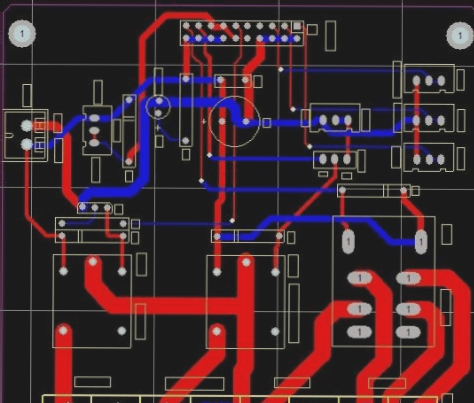Wiring is the most critical process in PCB design, as it directly influences the board’s performance. In the PCB design workflow, wiring generally falls into three categories:
1. **Basic Wiring**: This is the foundational requirement of PCB design. If connections are incomplete and there are numerous floating traces, the board will be deemed substandard—essentially, the design hasn’t even begun.
2. **Electrical Performance**: This aspect evaluates whether a printed circuit board meets the necessary qualifications. After layout deployment, it is essential to fine-tune the wiring to achieve optimal electrical performance.
3. **Aesthetics**: If your wiring is well-routed and does not compromise the performance of the electrical device, but appears chaotic and cluttered, then regardless of its electrical capabilities, it will still be viewed as subpar. Such disorganization complicates testing and maintenance. Therefore, wiring should be tidy and uniform, avoiding a haphazard and disorderly appearance. All of this must be accomplished while ensuring electrical performance and meeting any specific requirements; failure to do so could lead to significant issues.
1. The wiring process should adhere to the following principles:
1. Typically, power and ground lines should be routed first to ensure the circuit board’s electrical integrity. Whenever feasible, increase the width of these lines, with the ground line ideally being wider than the power line. The hierarchy is as follows: ground line > power line > signal line. Signal line widths generally range from 0.2 to 0.3 mm, with a minimum width of 0.05 to 0.07 mm. Power lines typically range from 1.2 to 2.5 mm. For PCBs in digital circuits, a wider ground wire can be looped to create a ground net (this method is not applicable for analog circuit grounds).

2. . Prioritize wiring high-requirement lines (such as high-frequency lines) early in the design process. Ensure that the input and output edge lines do not run parallel to avoid reflection interference. If necessary, incorporate ground wires for isolation, and ensure that wiring between adjacent layers is perpendicular to minimize parasitic coupling.
3. . The oscillator’s housing must be grounded, and the clock line should be kept as short as possible, avoiding excessive routing. The ground area beneath the clock oscillation circuit and any high-speed logic circuits should be expanded, ensuring that other signal lines do not encroach on this area to minimize the electric field.
4. . Prefer using 45-degree polyline wiring instead of 90-degree bends to reduce high-frequency signal radiation. (For lines with strict requirements, double-curved lines should also be employed.)
5. . Signal lines should not form loops. If looping is unavoidable, keep the loop size to a minimum, and use as few vias as possible for the signal lines.
6. . Critical lines should be kept short and wide, with protective ground added on both sides.
7. . For transmitting sensitive signals and signals from noisy fields through flat cables, utilize a “ground-signal-ground” configuration.
8. . Designate key signals with test points to facilitate production and maintenance testing.
9. . Once schematic wiring is completed, optimize the layout. After conducting a preliminary network inspection and ensuring the DRC checks are correct, fill any unwired areas with ground wire, utilizing a large copper area as the ground plane. All relevant areas should connect to ground. Alternatively, consider a multilayer board design, dedicating one layer each for power supply and ground.
–PCB Wiring Process Requirements
1. . Trace Width
Typically, the signal line width should be 0.3mm (12mil), while power lines should be 0.77mm (30mil) or 1.27mm (50mil). Maintain a spacing of at least 0.33mm (13mil) between lines and pads. In practical applications, increase this distance when feasible. In cases of high wiring density, using two lines between IC pins may be considered (though not recommended), with a line width of 0.254mm (10mil) and a spacing of no less than 0.254mm (10mil). In special situations where pins are closely spaced, line width and spacing can be reduced appropriately.
2. . Pad (PAD)
The basic requirements for pads (PAD) and vias (VIA) state that the pad diameter must exceed the hole diameter by 0.6mm. For general-purpose pin resistors, capacitors, and ICs, use a pad/hole size of 1.6mm/0.8mm (63mil/32mil); for sockets, pins, and diodes like the 1N4007, a size of 1.8mm/1.0mm (71mil/39mil) is recommended. In actual applications, adjust pad sizes according to the component dimensions, increasing sizes when conditions allow. The mounting aperture on the PCB should be approximately 0.2-0.4mm larger than the actual component pin size.
3. . Via (VIA)
Standard sizes are typically 1.27mm/0.7mm (50mil/28mil). In cases of high wiring density, vias can be reduced in size, though they should not become too small; sizes of 1.0mm/0.6mm (40mil/24mil) may be suitable.
4. . Pitch Requirements for Pads, Lines, and Vias
PAD and VIA: ≥ 0.3mm (12mil)
PAD and PAD: ≥ 0.3mm (12mil)
PAD and TRACK: ≥ 0.3mm (12mil)
TRACK and TRACK: ≥ 0.3mm (12mil)
For higher density:
PAD and VIA: ≥ 0.254mm (10mil)
PAD and PAD: ≥ 0.254mm (10mil)
PAD and TRACK: ≥ 0.254mm (10mil)
TRACK and TRACK: ≥ 0.254mm (10mil)
2. Wiring Optimization and Silk Screen Printing: “There is no best, only better!” Regardless of how thoughtfully designed, upon completing the layout, you will likely find areas for improvement. A general rule of thumb is that the optimization process will take about twice as long as the initial wiring. Once no further modifications are needed, copper can be laid (Place->polygon Plane), usually grounded (be mindful of separating analog and digital grounds). Power supply may also need a dedicated layer in multilayer boards. For silk screen printing, ensure that the design is not obstructed by components or vias. Also, orient the design toward the component surface, mirroring text on the bottom layer to avoid confusion.
3. Network and DRC Inspection and Structure Inspection: Firstly, ensure that the schematic design is correct. The generated PCB network file should be checked against the schematic network file through a NETCHECK to confirm connectivity. Revise the design as needed based on the output to maintain correct wiring connections. After passing the network check, conduct a DRC check on the PCB design, making necessary adjustments based on the output to ensure electrical performance. Finally, confirm the mechanical installation structure of the PCB.
4. Plate Making: Ideally, a review process should precede this step. PCB design requires careful consideration; those with insight and experience should approach the task with diligence. Consider various factors, including ease of maintenance and inspection, which are often overlooked. Continuous improvement will lead to the creation of a high-quality PCB design.




